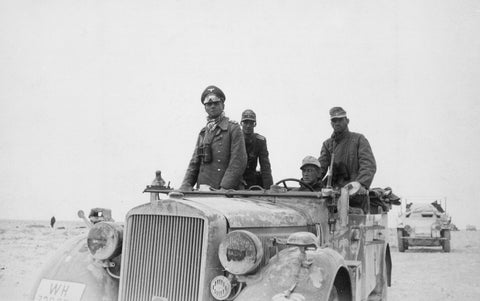
The Rise and Fall of Erwin Rommel
In this well-known but undated photograph taken in North Africa, famed German commander Erwin Rommel (left) stands in his staff car. According to the U.S. National Archives the image appears to show Rommel visiting the 15th Panzer Division somewhere in the Libyan desert between Tobruk and Sidi Omar circa 1941. Regardless of when or where exactly the photo was taken, Rommel appears here at the height of his powers. He had both tanks and infantry at his disposal, rugged terrain to explore and exploit and substantive freedom of action to pursue victories. His peaked service cap, scarf and goggles — the latter allegedly given to him by British Maj. Gen. Michael Gambier-Perry — became a signature part of his wartime image during his period of success.
Following his defeat at the Second Battle of El Alamein in late 1942, German war photographers took far fewer photos of the famous Desert Fox in the wilderness — Third Reich propagandists acted on the ethos that no news was better than bad news. Extant photos taken of Rommel in the desert while his star was declining show him appearing sickly, wrapped in a dark greatcoat and often wearing a different and shoddier-looking service cap.
After Rommel’s forces lost in North Africa, the once feted Field Marshal disappeared from German military newsreels altogether until Adolf Hitler’s High Command decided to exploit his former fame for propaganda purposes as he inspected the Atlantic Wall in 1944. Rommel by this time was no longer the same military commander who had achieved daring victories in the desert. In his memoirs and personal letters, he expressed bitterness and a deep-seated anger about the higher conduct of the war, especially regarding the fate of his troops who fought in North Africa.
historynet magazines
Our 9 best-selling history titles feature in-depth storytelling and iconic imagery to engage and inform on the people, the wars, and the events that shaped America and the world.
